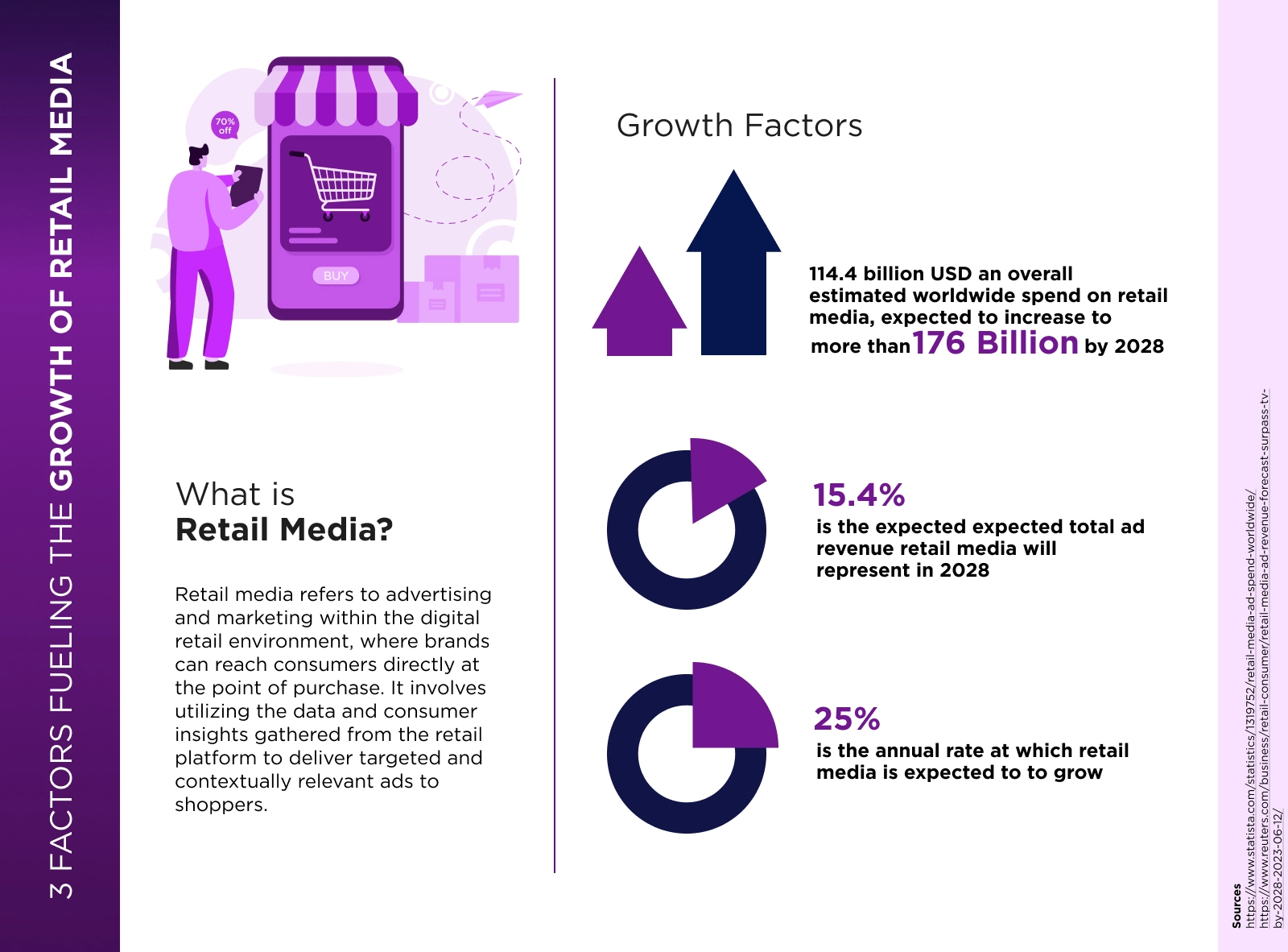The retail media landscape has experienced significant growth and transformation in recent years and is projected to grow at an annual rate of 25% in the next five years, reaching a substantial value of $100 billion. By 2026, it is expected that retail media spending will constitute over 25% of the total digital media expenditure[1].
The emergence of retail media has reshaped the advertising industry, offering brands unique opportunities to engage with their consumers while driving sales and revenue for retailers.
Retail media involves utilizing the data and consumer insights gathered from the retail platform to deliver targeted and contextually relevant ads to consumers.
What is Retail Media?
Retail media refers to advertising and marketing within the digital retail environment, where brands can reach consumers directly at the point of purchase. It involves utilizing the data and consumer insights gathered from the retail platform to deliver targeted and contextually relevant ads to shoppers.
Retail Media Networks (RMNs) are at the heart of retail media. These are advertising networks operated by retailers, which allow brands to place ads directly on the retailer’s website or app. RMNs enable brands to leverage the wealth of customer data available through the retail platform, allowing for precise targeting and personalization of ad content. By providing direct access to consumers during their active shopping moments, retail media networks enhance the overall shopping experience and significantly improves conversion rates for brands.
One of the essential aspects of retail media is that it goes beyond traditional advertising. It offers brands the ability to influence consumer behavior throughout the entire shopper journey, from awareness and consideration to purchase and loyalty. This is accomplished through various ad formats, such as sponsored product listings, display ads, native ads, and more.
What is Driving the Growth of Retail Media

Retail media has seen rapid adoption and expansion due to its effectiveness and ability to connect brands with shoppers in a highly relevant and targeted manner. According to recent statistics, retail media emerged as one of the most significant advertising trends in 2022, and its momentum remains strong with no indications of deceleration[2]. This growth can be attributed to the following key factors:
1. The Rise in eCommerce
The significant increase in total retail eCommerce sales in the US has played a crucial role in fueling the growth of retail media. The e-commerce market in the United States is set to experience a substantial and consistent growth trajectory from 2023 to 2027, with a projected increase of 509.4 billion U.S. dollars (+54.19 percent). This consistent upward trend is expected to continue for the fourth consecutive year, propelling the revenue to reach an impressive 1.4 trillion U.S. dollars, marking a new peak in 2027[3]. This surge in online shopping means that a substantial portion of the US population is engaging in frequent online purchases, leading to a higher exposure to digital advertisements.
For retailers, this presents a golden opportunity to leverage the wealth of purchase data gathered from eCommerce platforms. By tapping into this data, retailers can make their ad targeting and delivery more efficient and accurate. This level of precise targeting enables brands to reach the right audience at the right time, maximizing the impact of their advertisements and ultimately leading to higher conversion rates.
2. Proliferation of Ad Formats
While sponsored search ads remain a core component of retail media spending, the proliferation of various ad formats has been a key driver of its growth. Retail media networks have expanded their offerings to include a wide variety of ad formats, encompassing connected TV, video, off-site display, audio, and in-store media.
This versatility in ad formats gives advertisers the flexibility to reach consumers across various digital channels. Whether it’s through interactive video ads on connected TVs, engaging display ads on third-party websites, or in-store media placements, advertisers can effectively target consumers almost anywhere with any type of digital advertising. This adaptability and extensive reach make retail media an incredibly powerful tool for brands to enhance their advertising campaigns and connect with consumers on multiple touchpoints.
3. Building Strong Advertiser Partnerships
Establishing and growing a new ad format can be a challenging endeavor. To entice advertisers to invest their marketing dollars, it’s crucial to demonstrate the value and effectiveness of the platform. However, proving its worth can be difficult without advertiser partners already on board.
Retail media networks have overcome this obstacle by building strong relationships with advertisers. By partnering with prominent brands and demonstrating the positive outcomes of their ad campaigns, these networks have been able to attract more advertisers to join their platforms. As the number of advertiser partners increase, so does the appeal of the retail media network, creating a virtuous cycle of growth.
What Does this Growth Mean for Brands and Advertisers?
- Targeted Advertising: Retail media provides brands with access to granular consumer data, enabling precise targeting based on demographics, shopping behavior, purchase history, and preferences. This means ads are more relevant to consumers, leading to higher engagement and conversion rates.
- Enhanced Shopping Experience: For consumers, retail media means encountering ads that complement their shopping experience, offering product recommendations, deals, and personalized offers that align with their interests and needs.
- Data-Driven Insights: Brands gain valuable insights into consumer behavior, preferences, and purchasing patterns through retail media platforms. This data helps in refining marketing strategies, product development, and understanding consumer preferences better.
- Incremental Revenue for Retailers: Retailers benefit from retail media by generating additional revenue streams, enhancing their profit margins, and creating mutually beneficial partnerships with brands.
Summary
Retail media has emerged as a powerful and effective advertising channel, offering brands the ability to engage with consumers in a targeted and contextually relevant manner while driving sales and revenue for retailers. The growth of retail media can be attributed to factors such as the sunsetting of third-party cookies, closed-loop attribution, contextually relevant ads, audiences at scale, and the expansion of the eCommerce industry.
By understanding and capitalizing on retail media, brands can position themselves for success in the evolving landscape of retail media.
[1] https://www.bcg.com/publications/2022/how-media-is-shaping-retail
[2] https://www.campaignasia.com/article/six-ways-retail-media-is-evolving-in-2023/484031
[3] https://www.statista.com/statistics/272391/us-retail-e-commerce-sales-forecast/




















